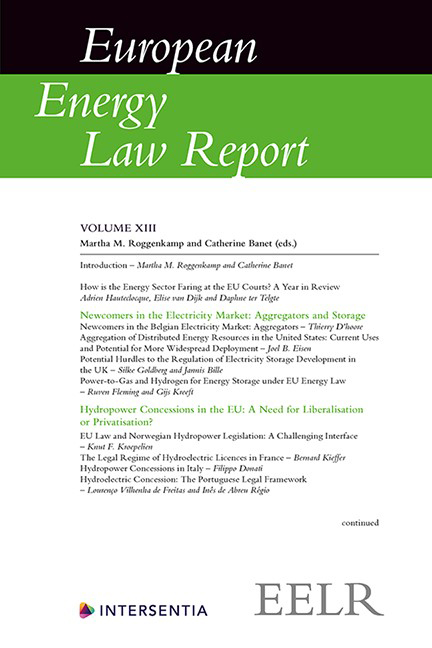Book contents
- Frontmatter
- Preface
- Contents
- List of Abbreviations
- List of Contributors
- Introduction
- Chapter I How is the Energy Sector Faring at the EU Courts? A Year in Review
- PART I NEWCOMERS IN THE ELECTRICITY MARKET: AGGREGATORS AND STORAGE
- PART II HYDROPOWER CONCESSIONS IN THE EU: A NEED FOR LIBERALISATION OR PRIVATISATION?
- PART III INVESTMENTS AND DISINVESTMENTS IN THE ENERGY SECTOR
- PART IV OFFSHORE DECOMMISSIONING IN THE NORTH SEA
- PART V CCS AS A CLIMATE TOOL: NORTH SEA PRACTICE
- PART VI FROM EU CLIMATE GOALS TO NATIONAL CLIMATE LAWS
Chapter XIX - Developments in UK Carbon Capture and Storage
Published online by Cambridge University Press: 30 April 2020
- Frontmatter
- Preface
- Contents
- List of Abbreviations
- List of Contributors
- Introduction
- Chapter I How is the Energy Sector Faring at the EU Courts? A Year in Review
- PART I NEWCOMERS IN THE ELECTRICITY MARKET: AGGREGATORS AND STORAGE
- PART II HYDROPOWER CONCESSIONS IN THE EU: A NEED FOR LIBERALISATION OR PRIVATISATION?
- PART III INVESTMENTS AND DISINVESTMENTS IN THE ENERGY SECTOR
- PART IV OFFSHORE DECOMMISSIONING IN THE NORTH SEA
- PART V CCS AS A CLIMATE TOOL: NORTH SEA PRACTICE
- PART VI FROM EU CLIMATE GOALS TO NATIONAL CLIMATE LAWS
Summary
INTRODUCTION
CO2 has been transformed in recent years in both scientific and popular understanding from an inert gas of limited significance beyond certain industrial processes to a substance whose presence in increased quantities in the atmosphere is now known to pose considerable risks in the shape of global warming and climate change. In this context, a wide array of international, regional and domestic initiatives have been undertaken with a view to reducing its emission into the atmosphere. Recognising that ultimately the required level of reduction will depend upon a substantial shift from dependence on fossil fuels to renewable sources of energy, but also that this shift is unlikely to occur quickly enough to prevent problems – given political, economic and technological constraints – interest has grown in the possibility of capturing CO2 as it is produced in the burning of fossil fuels or in other industrial processes, and then sequestering it permanently in geological formations (such as saline aquifers or depleted hydrocarbon reservoirs) – a process known as carbon capture and storage (CCS). Deploying the technology would thus allow governments to meet the dual objectives of emissions reduction and energy security.
This response to the problem of CO2 raises both technological and legal challenges. Within the EU there is a desire to see the required technology developed and demonstrated in order that CCS may become part of the overall solution to the problem of greenhouse gases (GHGs). To this end, the Carbon Capture and Storage Directive establishes a framework within which commercial actors may be reassured about the extent of the liability they are taking on and the point at which they may transfer long-term liability for sequestered CO2 to the state. In parallel, of course, the Directive also seeks to reassure states that they are only taking on long-term liability for sequestered CO2 at the point at which they may be satisfied that it will indeed remain where it has been put. In this last regard, there are encouraging data from the Intergovernmental Panel on Climate Change, which reports that
Observations from engineered and natural analogues as well as models suggest that the fraction retained in appropriately selected and managed geological reservoirs is very likely to exceed 99% over 100 years and is likely to exceed 99% over 1,000 years.
- Type
- Chapter
- Information
- European Energy Law Report XIII , pp. 387 - 404Publisher: IntersentiaPrint publication year: 2020



